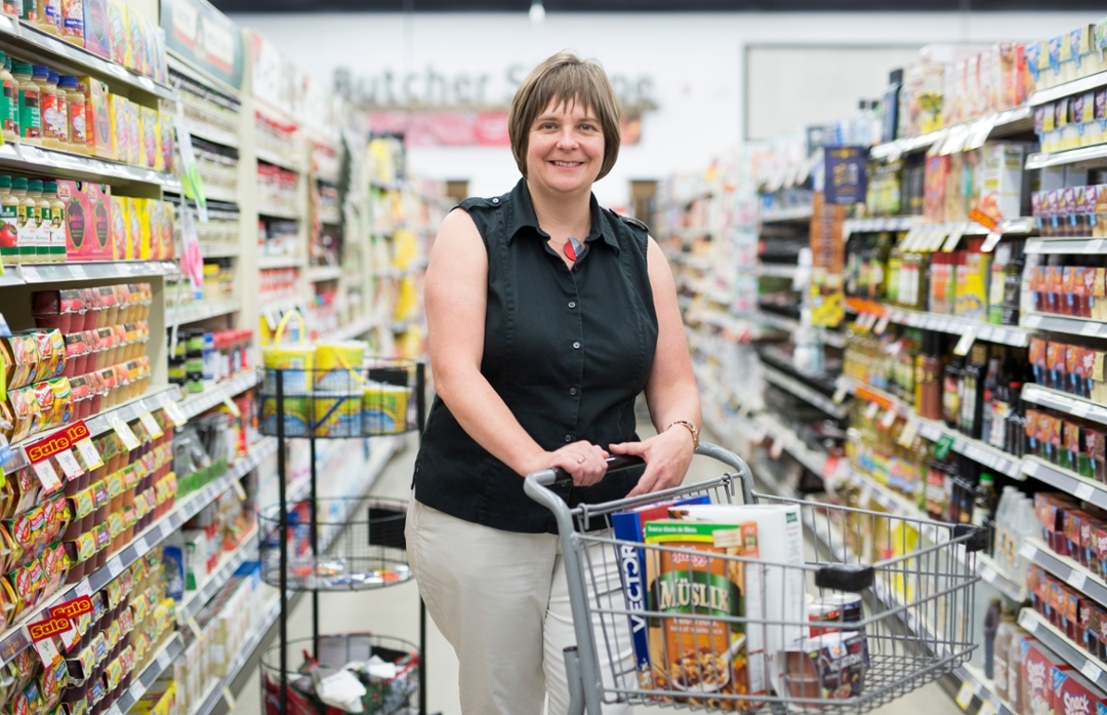
Dilema in aisle 3
Jill Hobbs is peering into the enigmatic ways of today’s shoppers and how they’re revolutionizing the food business.
By Glenn CheaterYou find them in every grocery store aisle—shoppers blinking perplexedly at ingredient labels, others filling their carts with trendy products promising better health (or a healthier planet).
These commonplace acts fascinate Jill Hobbs, a self-described foodie.
“How do consumers make these decisions?” asked the U of S agricultural economist, an expert in consumer behaviour and food supply chains.
“Do they think them through ahead of time? Do they take a cognitive shortcut and just say to themselves, ‘I trust this or that celebrity or what my friend says and I’m just going to buy whatever she or he recommends?’ Or do certain types of labels grab their attention?
Take eggs, for example, which hold a special place in her heart. As a girl growing up in the U.K., Hobbs sold brown eggs from the family farm in the neighbouring village—although the choices were limited in the extreme.
“You could buy big eggs or small ones,” she said at a conference earlier this year before treating her audience to a tsunami of egg offerings she had discovered during a recent trip home.
Of course, there were regular free-range eggs (one company markets ‘happy eggs’), but you could also get free-range from heritage breeds (three dollars for a half dozen laid by Columbian Blacktails and nearly five dollars for six Old Cotwold Legbar eggs). Or perhaps you’d prefer free-rangers from East Anglia or Wales; ones from chickens fed corn (for ‘golden’ yolks); eggs that support charitable causes; omega 3 eggs; or ones promising more selenium. Hobbs’ favourite is a brand called Ella Valentine that sells large eggs in bright pink cartons and promises “these big beauties will make your cakes fluffy and your desserts delicious.”
In one sense, it’s all good fun.
“For some consumers, these attributes are very important and they’re willing to pay more for them while for other consumers, they’re not,” noted Hobbs. “The market is good at sorting these things out.”
And it’s been doing a lot of sorting lately. Grocery and restaurant chains are not only tracking consumer preferences like never before, they’re also rushing to appeal to those who want something different, even if that means turning their supply chains on their ear. And more and more consumers are paying premiums for products they believe, rightly or wrongly, have special benefits.
“Understanding how consumers make these decisions both before they go to the store and when they’re there, getting hit with all this information, is pretty important,” said Hobbs, who joined the U of S faculty in 1999.
“Researchers are now trying to dig down into how consumers make decisions and what influences them—what we call food values and cultural cognition. How do people process information about science and food issues?”
It’s a tangled web, and getting more so as Facebook, Twitter and other social media offer persuasive individuals and celebrities-turned-health-experts an extremely powerful platform to influence others.
“Clearly social media is pretty influential in terms of spreading information. Whether it’s accurate information, of course, is a whole other issue,” she said. “Then you have terms like ‘natural,’ which really don’t mean anything. I could put the word natural on any product because we don’t have a regulatory definition of that term. So it’s hard for consumers to know what is a credible claim and what’s just a marketing ploy.”
But there are problems with the sober and responsible alternative: government-approved labels.
Canada has a stringent system for deciding what goes on labels, but they’re not exactly consumer friendly. Every year, Hobbs conducts a little experiment with her fourth-year agricultural marketing systems class. She passes around a few products, such as canned vegetables and maple syrup, and asks her students what the product grade information on the labels (terms such as Canada Fancy or Canada Choice) means.
“Even though they are closer to the ag industry than most consumers, most of them don’t know,” she said. “I’m not surprised by that. It’s a good example of having too much information on a label that’s not all that useful to consumers.”
Another issue arises when it comes to health claims. Again, federal regulators do a good job to ensure any claims are supported by science, numerous studies, and “the benefits come from consuming the product in normal amounts,” said Hobbs. But it’s a slow and cumbersome process.
“On the other hand, the U.S. has a looser regulatory system that allows what’s called ‘qualified health claims,’ so you can have claims with a whole bunch of qualifiers,” she added. “It’s been criticized because it weakens the health claim. You need to have a balance—one that protects consumers but also encourages industry to bring products to the market that have real health benefits.”
And behind all of these issues, she explained, is the fact we are all so different. We care deeply about food but in many different ways—and you can’t look at someone’s background and predict what they care about.
“You can’t make blanket statements that consumers are concerned about x, y, and z,” said Hobbs. “Some are very motivated by environmental issues; some people are very focused on health; some are very busy and want convenience; and for some, it’s about price. But you can’t simply classify those interests by age, gender, education or those sorts of social demographics.
So perplexed shoppers and impulsive ones will continue to populate our grocery stores for many years to come. And the list of things they are concerned about will only get longer, said Hobbs.
“This is a trend with a whole bunch of different dimensions — animal welfare, food safety, traceability, GMOs, and so forth,” she said. “And even as new issues emerge, there will always be more percolating in the background.”

